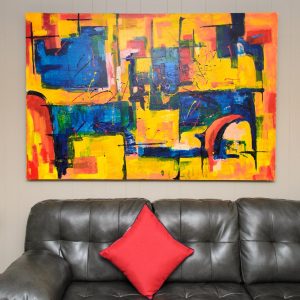Collecting art means very different things for different people. Art is a personal, yet universal subject that touches people in a myriad of ways. The desire to have art within one’s home can be strong, but intimidating. However, starting an art collection is not as hard as one might think.
A common misconception is that all art is ridiculously expensive. No matter the budget, there is a work of art out there that fits into it. A key to finding less expensive pieces is to consider lesser known artists, small pieces, and pieces that are not unique one-of-a-kinds. An artist who is up and coming would not have the fame to their name like Andy Warhol, therefore their works of art would be less in demand, thus less expensive. The size of a piece also factors into how much it would sell for. A painting that is only 12 inches by 18 inches would typically cost less than a painting that is 36 inches by 40 inches. Lastly, many artists create editions of their works. What that means is that there are multiple pieces created by the artist that look the same so that several people can own a copy. A piece that is an edition of 100 would not cost as much as a piece that is not an edition, or even one that is an edition of 5, because the more the availability of the piece, the less it is worth. Regardless, the first piece of art bought will always be the most daunting, however, as the phrase goes, there is no time like the present!
Different types of prints are:
Another aspect of art collecting that causes people to hesitate is intimidation. Money, surely, can be intimidating – the cost, the blaise attitude of dealers and clients – but more than that, some people are intimidated by the very art themselves. I often hear people say that they do not understand art or know how to talk about art. These statements are exactly the opposite of what art truly is. Much of art is making a piece that simply makes the viewer feel something. There is not always a specific message to understand. Sure, sometimes there is, but ultimately when it comes to art, the feelings that one feels when they see it is what counts. Being able to explain what the art makes you think about or feel is being able to understand and talk about art. Assuming that there is fancy language and deeper meanings with every art piece and you need to be able to discuss that in order to be a collector is not the case. It boils down to what you as a person think and once coming to terms with that, art will not be so intimidating.

Starting an Art Collection
Even with all of the aspects that could be seen as cons, the pros often weigh heavier. For someone who loves art, it makes sense to surround oneself with pieces that make us smile. Art alters the environment it is in, adding aesthetics and fostering pleasure and creativity. Some people collect art because they desire the culture and sophistication that comes along with it. Getting to know art in different cultures opens the door for a wider understanding of people. Art is a universal language that anyone can understand.
How:
– Check out galleries and auction houses, join their mailing lists, get to know them as people
– “A balanced way to start collecting new art is to invest in small works by both established and lesser-known names.”
How to know what art is best for you:
– Your collection is for you so do not worry about what is expected or what one “should” collect. Collect pieces that mean something or speak to you and curate your own personal art trove.




